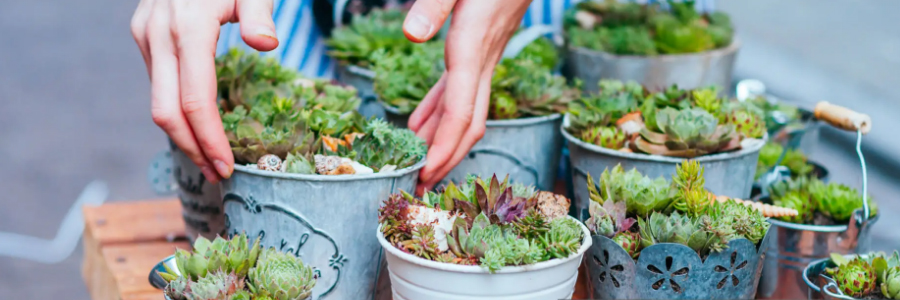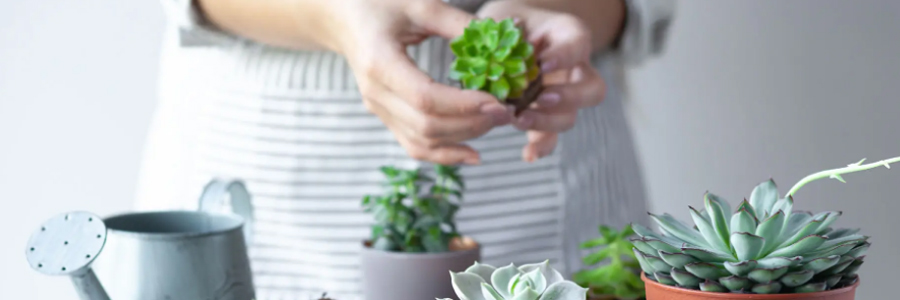Ideal Media and Soils for Growing Succulents
Components of Succulent – Friendly Media
1.Inorganic Materials
Sand: Coarse sand is a common component in succulent soil mixes. It improves drainage by preventing the soil from compacting and allowing water to flow freely through the pores. The large – sized particles of sand create spaces for air circulation around the roots, which is crucial for healthy root growth. For example, in a desert – inspired succulent garden, a significant amount of sand in the soil mimics the natural arid environment where many succulents originate.
Perlite: Perlite is a lightweight, porous volcanic rock. It helps with drainage and aeration in the soil. When added to a succulent mix, perlite increases the porosity of the soil, ensuring that water doesn’t pool around the roots. It also lightens the soil texture, making it easier for roots to penetrate. In a potting mix for indoor succulents, perlite can be mixed with other components to create an ideal growing environment.
Vermiculite: Vermiculite is another mineral – based material that can be used in succulent soils. It has a high water – holding capacity, which can be beneficial in retaining some moisture for the plants. However, it should be used in moderation as too much vermiculite can lead to waterlogged conditions. In areas with very dry air, a small amount of vermiculite in the soil can help keep the succulents hydrated.
2.Organic Matter
Peat Moss: Peat moss is a common organic component in succulent soil mixes. It helps retain some moisture while also providing a small amount of nutrients. However, it should be used sparingly as it can hold too much water if not balanced with inorganic materials. In a well – balanced succulent soil, peat moss can contribute to the overall structure and fertility of the soil.
Composted Bark: Composted bark is a slow – releasing source of organic matter. It improves soil structure and aeration. The decomposed bark provides a natural and long – lasting source of nutrients for the succulents. For outdoor succulent gardens, composted bark can be mixed with other components to create a sustainable and nutrient – rich growing medium.
Coconut Coir: Coconut coir, made from the husks of coconuts, is an eco – friendly alternative to peat moss. It has good water – holding capacity and also helps with soil aeration. Coconut coir is a renewable resource and is becoming increasingly popular in succulent cultivation. It can be used in both indoor and outdoor succulent plantings.
Types of Succulent – Specific Soils
1.Commercial Cactus and Succulent Mixes
These pre – made mixes are formulated to meet the specific needs of succulents. They typically contain a blend of sand, perlite, and a small amount of organic matter. Commercial mixes are convenient as they are already balanced and ready to use. For beginners, a high – quality commercial cactus and succulent mix can be a great starting point for growing succulents. Brands like Miracle – Gro Cactus, Palm & Citrus Potting Mix are popular choices.
2.DIY Succulent Soils
For those who prefer a more customized approach, making your own succulent soil can be rewarding. A basic DIY succulent soil recipe could be 50% inorganic materials (such as a combination of sand and perlite) and 50% organic matter (like peat moss and composted bark). However, the ratio can be adjusted depending on the specific needs of the succulent species. For example, if you are growing a very drought – tolerant succulent, you might increase the proportion of sand and perlite to enhance drainage.
3.Specialty Soils for Different Succulent Types
Desert Succulents: Succulents native to desert regions, such as cacti, require a soil mix with excellent drainage. A soil mix with a high proportion of sand and perlite, perhaps up to 70 – 80% inorganic materials, would be suitable. This mimics the fast – draining sandy soils of their natural habitats.
Forest Succulents: Some succulents, like certain Haworthia species, are native to forest floors. These plants prefer a soil mix that retains a bit more moisture. A mix with a slightly higher proportion of organic matter, around 40 – 50%, along with sand and perlite, can be ideal for these forest – dwelling succulents.
Adjusting the Soil for Different Growing Conditions
1.Indoor Growing
When growing succulents indoors, the soil should be well – draining but also able to retain some moisture as indoor environments can be relatively dry. A mix with a bit more organic matter, around 30 – 40%, and a good balance of sand and perlite can be suitable. You may also need to consider adding a slow – release fertilizer to the soil to provide nutrients, as indoor succulents may not have access to the same level of natural nutrients as outdoor plants.
Outdoor Growing
In outdoor settings, the soil needs to withstand various weather conditions. In areas with heavy rainfall, a soil mix with a higher proportion of inorganic materials (up to 70%) is recommended to ensure quick drainage and prevent waterlogging. In drier outdoor areas, a slightly more moisture – retentive soil, with around 40% organic matter, can be beneficial.



